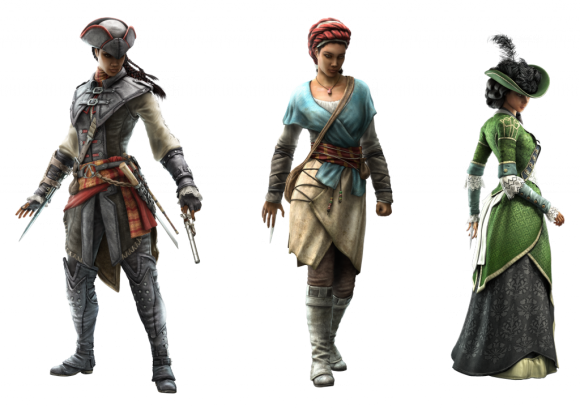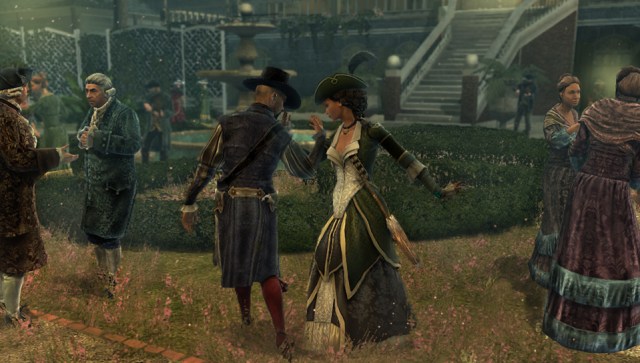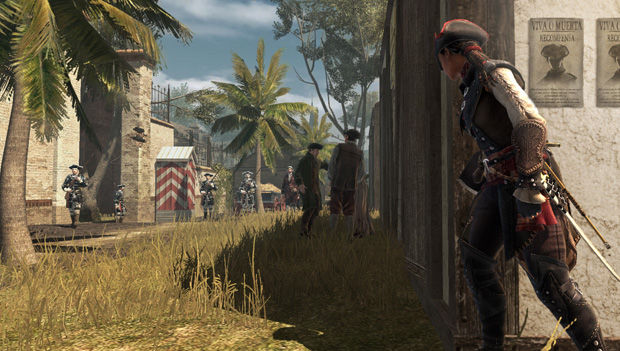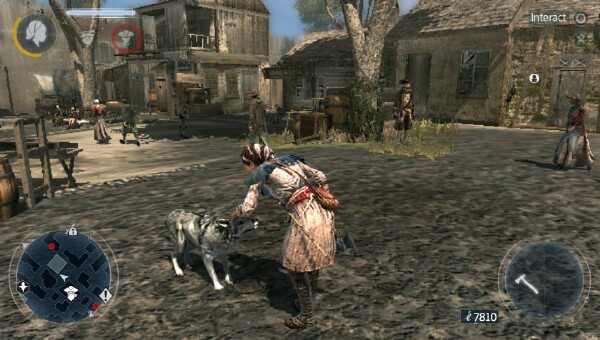Assassin’s Creed: Liberation is definitely a unique game in the Assassin’s Creed series, not just because it’s the first (and really only) game in the series to feature a woman, a woman of color even, as the main protagonist. Because it’s also the only AC game on the (criminally underutilized) PlayStation Vita system, it also means that they played a bit more with the formula, adding some new mechanics that haven’t been in past games in the series. One of them is the use of disguises. Now, the fact that this mechanic is only in the game with the female protag is, of course, extremely gendered, especially since part of it is to allow the character to seduce targets and also limit her movement. But I think it was an interesting move, and while I may not have always found it completely successful, I do think it’s a mechanic worth talking about, because there aren’t that many games out there that make clothing part of the actual gameplay, instead of merely window dressing.
I suppose you could argue that any game with armor sets is making clothing part of the gameplay, and to some extent that’s true. But armor is based all on stats, and all it effects is how much damage an enemy is going to do to you, or other status effects that are beneficial (or sometimes detrimental) to your character. Assassin’s Creed: Liberation’s use of clothing doesn’t just affect your stats: it actually effects how other people perceive you and react to you. They’re disguises, meant to help Aveline blend in (or in the case of the Lady outfit, stand out). It’s a more intuitive way of using clothing, and I think it adds an element that a lot of stealth games could explore more, but choose not to.
Aveline has three basic outfits to choose from. The Lady outfit is a not-very-accurate depiction of what well-to-do women wore in the 1770s, something that she, as the daughter of a rich New Orleans merchant, would be expected to wear. I won’t go into huge details about why this outfit is wrong for the period – the fabric choice is wrong, the shape is wrong, it’s way too 20th century sexy, to name a few. But I digress. In this disguise, your mobility is pretty severely limited due to corsets and panniers and wearing such a heavy garment, and you only are armed with your hidden blade.
But your notoriety is lower, and Aveline is also granted the ability to seduce targets away from their posts and subtly take them out sight unseen. There’s a part of me that really hates this mechanic – Aveline is of course the only AC character who has this ability, pretty much all of the other AC protagonists at this point being men, and none of the men who followed her have it either. But on the other hand, it’s incredibly useful. There’s one mission where I blended with the crowds at a party to get close to my target, then seduced him around to the back of his covered porch, where no one could see us. Then I struck, and left the same way, without a single guard being the wiser.
For all of Assassin’s Creed’s acrobatics and Eagle views, and air assassinations, at this moment is when I felt most like an assassin. There was a great sense of satisfaction in fooling so many people, and none of them ever being the wiser.
The other two outfits are Aveline’s Assassin outfit and the Slave outfit, the former of which is her version of the typical Assassin’s garb, although she doesn’t wear the typical hood or long jacket (because it must be visually obvious that she is a hot woman at all times, I suppose). It has the most mobility, the most weapons, but also much more notoriety than the Lady outfit. Then there’s the “Slave” outfit. I understand why this outfit is useful, though I question its execution—Aveline spends a lot of time freeing slaves, so such a disguise is necessary for infiltrating plantations and such. But, for starters, there really isn’t such a thing as a “slave outfit.” What a colonial era slave wore depended on so many things—were you working in the field or in the house, how rich your owners were, whether or not they cared how their slaves were dressed.
What marked a person as a slave in the 1770s American South was not what a person wore, but the color of their skin. So a disguise for this isn’t really necessary. Not to mention the fact that it’s weirdly anachronistic compared to the two other outfits. It looks like something that a Brooklyn hipster would wear. It is ridiculous. Naturally this outfit gains you the most notoriety the more illegal acts you commit while wearing it, but it does help you blend in in certain places (like the aforementioned plantations) but, like the Lady outfit, it doesn’t have any armor, so your available health goes down pretty significantly.
These outfits are meant to be worn situationally, and sparingly, but I think they serve a symbolic purpose as well. The Lady is the person that her father wants her to be, that the upper crust of New Orleans expects her to be, beautiful and subservient. The Slave outfit is who people expect her to be based on the colour of her skin. But the Assassin’s outfit is her true self, when she gets to be who, and what, she really is, free from expectations based on her heritage or her gender. It is no accident that her Assassin’s garb gives her the most freedom of movement, as well as the most ways to be lethal.
While I think it’s an interesting choice to make situational-specific disguises, the game doesn’t quite execute them in an effective way. Most missions that require them will tell you which one to wear, which takes a lot of the fun out of it, honestly, and can make assassinations almost too easy. Being able to complete an assassination using a combination, or using any of them, probably would have been much more effective and interesting. Imagine infiltrating a party to reach a target as a servant/slave by coming through the front door on some kind of errand, then changing and becoming a guest. Changing into them is rather clunky as well, with Superman-like clothing stores/changing booths scattered about New Orleans. The only way you can change is to use one, and it doesn’t work quite as organically as it should.
The Assassin’s Creed games have kind of a weird history with using disguises. In the first game, Altair’s robes were specifically designed so that he can escape notice, so that he can pull up his hood and blend in with monks roaming around the city. Because the first game didn’t have things like air assassinations, sometimes blending with a roving group of monks was the only way to enter an area unnoticed. But in later games they’ve kind of gotten further away from that concept, with the outfits getting more and more anachronistic and inappropriate as the series goes on. The recently revealed Jacob Frye’s outfit makes almost no sense for someone who is supposed to be a) incognito and b) poor, or at least appearing that way. I will admit he does look cool; it’s just that it’s way too flashy.
For a series that prides itself in historical accuracy in some respects, when it comes to clothing, they do not give any f*cks, and it gets worse with each new installment.) The signature Assassin’s Creed robe and hood have kind of taken on a life of its own, and it often doesn’t really work. There’s nothing about Assassin’s Creed robes now that scream “stealth” or “subtle”, which are pretty much the exact things a real assassin would want in their choice of garment. Outfit customization has been possible since Assassin’s Creed II, but it serves no more than an aesthetic purpose.
Changing the colour of your outfit doesn’t even make your notoriety go down, when it probably normally would in that situation—in a time when most people only had a couple of pairs of clothes, a costume change could render a person nearly invisible. In the Venetian masquerade sequence, no one should have been able to recognize Ezio at all, unless he was committing a crime in front of them—the entire point of the masks was to get away with things unrecognized, as it also allowed people to wear clothing that may or may not represent their true station. Instead of using clothing to gain access to areas, the games prefer to use other humans as the disguise (see; the prostitutes and mercenaries) a tactic that rarely functions as well as you want it to, though it works much better in the newer games.
In reality, an assassin would use any tool that they have to reach their targets, and this would not always be through physical skill. Keeping this in mind definitely makes the assassinations in Liberation more interesting and memorable than in other Assassin’s Creed games. And in a series that now has a new game out every year, mixing up the formula of “hidehidehide, climb a thing, jumpystab”, can only make the games better. My favourite Assassin’s Creed mission is one from Revelations, where you have to infiltrate Topkapi Palace, and Ezio does so by disguising himself as an entertainer at a party being held at the palace. Not only is it hilarious (Ezio is not a very good singer), but I was so excited to finally get to use a disguise. (I love the Lady Boyle mission in Dishonored for similar reasons; sure it is HELL to get into that house, but once you’re in, not only do none of the party guests recognize you, but they think you’re in costume as yourself. It’s glorious.) And it didn’t make the mission any easier, it just gives the player a more interesting way to go about completing it. Anyone can hide in a bale of hay and hope no one sticks a bayonet in there—the truly stealthy know how to hide in plain sight. And for that Aveline is an Assassin who outclasses any of the men who have come before or after her.
Megan Patterson is a freelance writer and the science and tech editor of Paper Droids, a feminist geek culture site. When she’s not writing, you can find her on Twitter, talking about how cute she is or crying over something ridiculous (usually videogames).
—Please make note of The Mary Sue’s general comment policy.—
Do you follow The Mary Sue on Twitter, Facebook, Tumblr, Pinterest, & Google +?











